The Manaslu Region holds an intriguing surprise for trekkers in the form of Mount Himlung. Positioned to the northeast of the Annapurna Range, this aspiring peak reaches a height of 7,126 meters. Nestled in a remote corner straddling the Nepal-Tibet border, Mount Himlung stands as a distinct presence. In the realm of 7000-meter peaks, Himlung distinguishes itself with a relatively approachable technical profile.
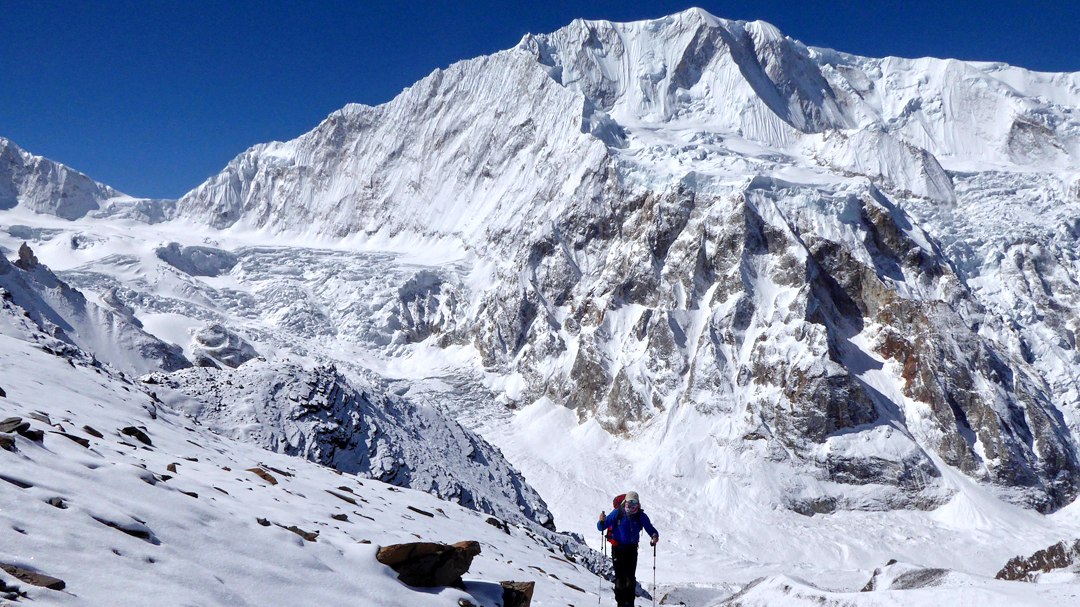
The journey to conquer Himlung follows the well-trodden Annapurna route up to Koto, and from there, ventures onwards to Nar-Phu Gaun. A more recent addition to this trail is the path from Nar-Phu Gaun to Manang, revealing a treasure trove of towering peaks and traverses. En route, trekkers are treated to glaciers, gullies, springs, and the enchanting presence of remote villages, each brimming with rich cultural experiences. The vistas encompass remarkable sights such as Api Himal, Kappa Chuli Peak, Nandadevi, and more.
Situated at an elevation of 4,900 meters, the base camp of Mount Himlung sets the stage for the ascent. Three higher camps are strategically positioned at altitudes of 5,450 meters, 6,000 meters, and 6,350 meters respectively. The final leg of the summit involves navigating a steep and icy path. Typically, the entire endeavor, from conquering the peak to returning to the base camp, spans ten to fifteen days. Since its opening to climbers in 1992, the inaugural ascent was achieved by a Japanese team in the same year. The number of successful climbs remains limited, with only a handful of teams achieving this feat. While comparably less challenging than other peaks, ascending Mount Himlung necessitates a high level of physical fitness. Isolated in its magnificence, Himlung Himal presents an awe-inspiring exploration opportunity for those seeking the summit.
Highlights of the Himlung Himal
- Stunning Views: Panoramic vistas of neighboring peaks like Annapurna and Manaslu offer breathtaking Himalayan scenery.
- Remote Adventure: Journey through remote villages and less-traveled trails for a unique cultural experience.
- Technical Challenge: Ascend a 7,000-meter peak with technical sections, crevasses, and icefalls for an adventurous climb.
- Gradual Acclimatization: Trekking through various altitudes and establishing high camps allows gradual acclimatization.
- Cultural Immersion: Immerse in local cultures, witness traditional lifestyles, and interact with indigenous communities.
- Team Bonding: Climbing in a team fosters camaraderie and teamwork with fellow climbers and support staff.
- Sense of Achievement: Reaching the summit brings a profound sense of accomplishment and awe-inspiring views.
- Personal Growth: Solitude in the Himalayas offers moments of reflection, spiritual connection, and personal growth.
- Challenging Environment: Overcoming weather and terrain challenges adds adventure to the climb.
- Supporting Local Economy: Participating in guided expeditions supports local guides, porters, and communities.
Routes to Climb Himlung Himal
There are a few different routes that climbers can take to ascend Himlung Himal, each with its own challenges and characteristics. Here are a couple of the most common routes:
Northwest Ridge Route
- This is the standard route used by most climbers to reach the summit of Himlung Himal.
- The route starts from the village of Koto, which is accessible from Besisahar along the Annapurna Circuit trail.
- Climbers trek through picturesque landscapes and traditional villages before reaching the base camp of Himlung Himal.
- The route involves establishing several high camps to aid in acclimatization before attempting the summit.
- The climb includes moderately steep slopes, glaciers, and some technical sections requiring the use of ice axes, crampons, and ropes.
- After reaching the summit, climbers descend back to the base camp and then trek back to Koto and Besisahar.
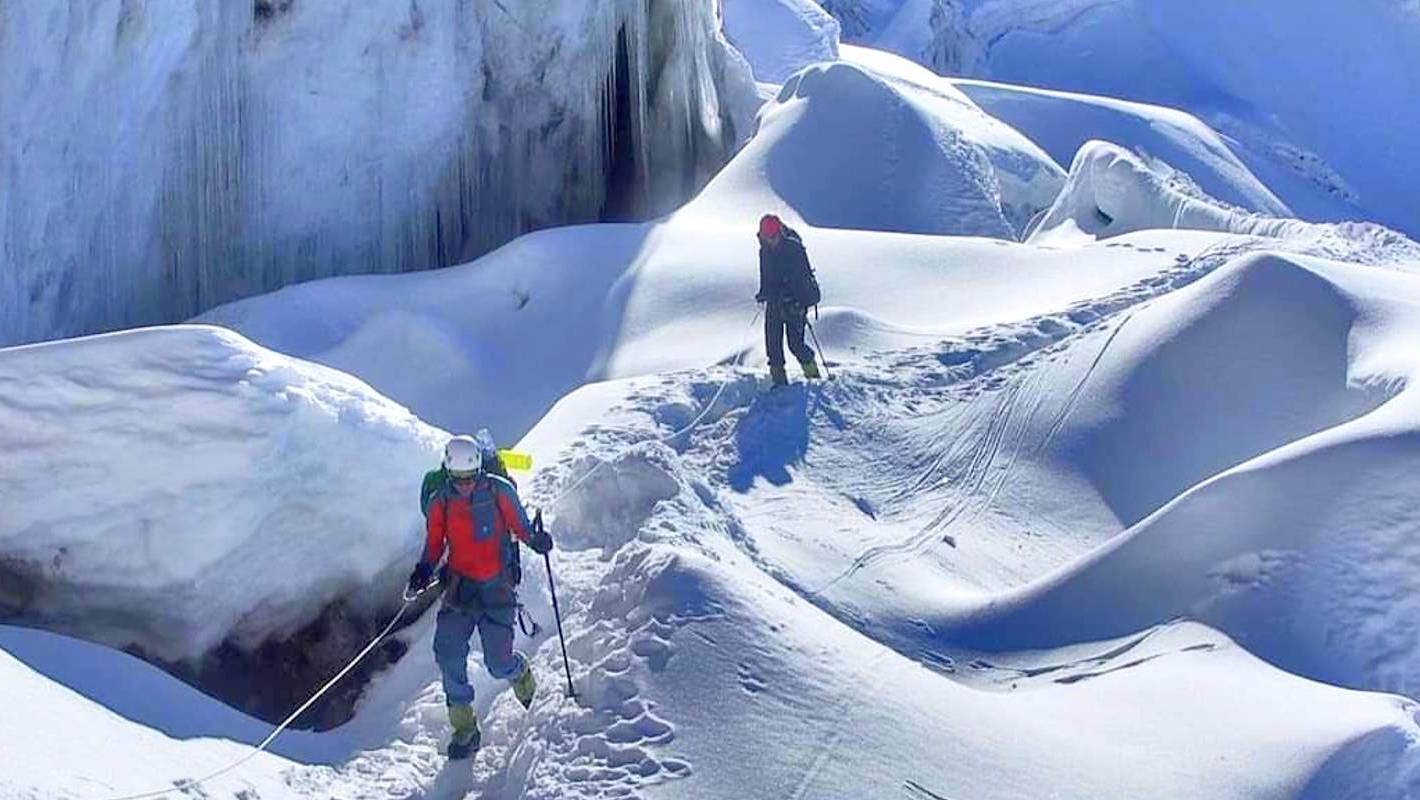
Northeast Ridge Route
- This is a less commonly used route and is considered more challenging and technical than the standard route.
- The route starts from the village of Phu, which is accessed by a side trek from the main Annapurna Circuit trail.
- Climbers will need to cross the Kang La Pass (5,320 meters) to reach the village of Phu before proceeding towards Himlung Himal.
- The climb involves steep and technical sections, including icefalls and crevasses.
- This route requires solid mountaineering skills and experience due to its technical nature.
- After the summit, climbers descend back to Phu and retrace their steps to the main trail.
South Face Route
- The south-face route is a more challenging and less frequented route.
- Climbers access this route from the Nar Phu Valley, which is reached by a detour from the Annapurna Circuit trail.
- The climb involves technical ice and mixed climbing, making it suitable only for experienced mountaineers.
- The approach to the south face is less straightforward and involves crossing high passes.
- Due to the technical difficulties and complex logistics, this route is attempted by fewer climbers.
It's important to note that the conditions and popularity of routes can change over time, and the choice of route should be made based on your experience, skills, and the advice of experienced climbers or trekking agencies. Regardless of the route you choose, proper acclimatization, training, and safety precautions are essential for a successful and safe ascent of Himlung Himal. Always consult with local experts and guides to ensure that you're well-prepared for the challenges of the chosen route.
Difficulty level to Climb Himlung Himal
Climbing Himlung Himal, which stands at an elevation of 7,126 meters (23,345 feet), presents a significant mountaineering challenge. The difficulty level of the climb is influenced by factors such as altitude, technical terrain, weather conditions, and the overall experience of the climbers. Here's an overview of the difficulty level involved in climbing Himlung Himal:
Altitude: Himlung Himal's altitude places climbers in a region with lower oxygen levels, resulting in physiological challenges. At higher altitudes, the air is thinner, which means there's less oxygen available for the body to function. This can lead to altitude-related issues such as altitude sickness, which includes symptoms like headache, nausea, fatigue, and shortness of breath. Climbers need to acclimatize gradually to give their bodies time to adjust to the changing environment.
Technical Terrain: The technical aspects of climbing Himlung Himal vary based on the chosen route. Climbers can encounter glacier travel, steep snow slopes, icy sections, and possibly rocky areas. These sections may require the use of specific mountaineering techniques and equipment. For example, steep slopes might demand the use of ice axes and crampons for secure footing, while navigating crevasses may require roped team travel and self-arrest skills.
Weather: The weather conditions in the Himalayas can be extremely unpredictable and challenging. Climbers should be prepared for cold temperatures, especially at higher altitudes. Sudden changes in weather, including snowstorms and high winds, can increase the difficulty of the climb and pose safety risks. Proper clothing and equipment are essential to protect against the elements.
Acclimatization: Adequate acclimatization is crucial for the body to adapt to higher altitudes and reduced oxygen levels. Climbers follow a gradual ascent profile, which involves spending time at intermediate altitudes before reaching the summit. This approach helps reduce the risk of altitude sickness and enhances overall climbing performance.
Duration: The extended duration of the expedition adds to the physical and mental challenges of climbing Himlung Himal. Long days of trekking and climbing, often in demanding terrain, require sustained physical endurance. The mental aspect includes dealing with the cumulative effects of fatigue, maintaining focus, and managing emotions.
Physical Fitness: Excellent physical fitness is a prerequisite for climbing Himlung Himal. Cardiovascular endurance is vital for climbing at high altitudes, as the body needs to efficiently use available oxygen. Muscular strength and stamina are essential for carrying heavy packs, navigating challenging terrain, and ascending steep slopes.

Experience: Climbers attempting Himlung Himal should have prior mountaineering experience. Familiarity with mountaineering equipment, techniques, and safety practices is crucial. Experienced climbers are better equipped to assess risks, make decisions in challenging situations, and respond effectively to unexpected circumstances.
Guides and Support: Many climbers opt for guided expeditions to Himlung Himal, led by experienced Sherpa guides and support teams. These guides provide local knowledge, route expertise, and logistical support. They contribute to safety by managing technical sections, evaluating weather conditions, and providing guidance in emergency situations.
While Himlung Himal is not among the highest peaks in the Himalayas, it still requires a high level of mountaineering skill and experience. Climbers should be well-prepared physically, mentally, and logistically, and they should approach the climb with respect for the challenges it presents. As with any high-altitude endeavor, safety should always be the top priority.
Weather and Climate for Climbing Himlung Himal
The weather and climate for climbing Himlung Himal are significant factors that can greatly influence the success and safety of the expedition. The Himalayas have unique weather patterns due to their elevation and geographical features. Here's a detailed overview of the weather and climate conditions climbers can expect when attempting to climb Himlung Himal:
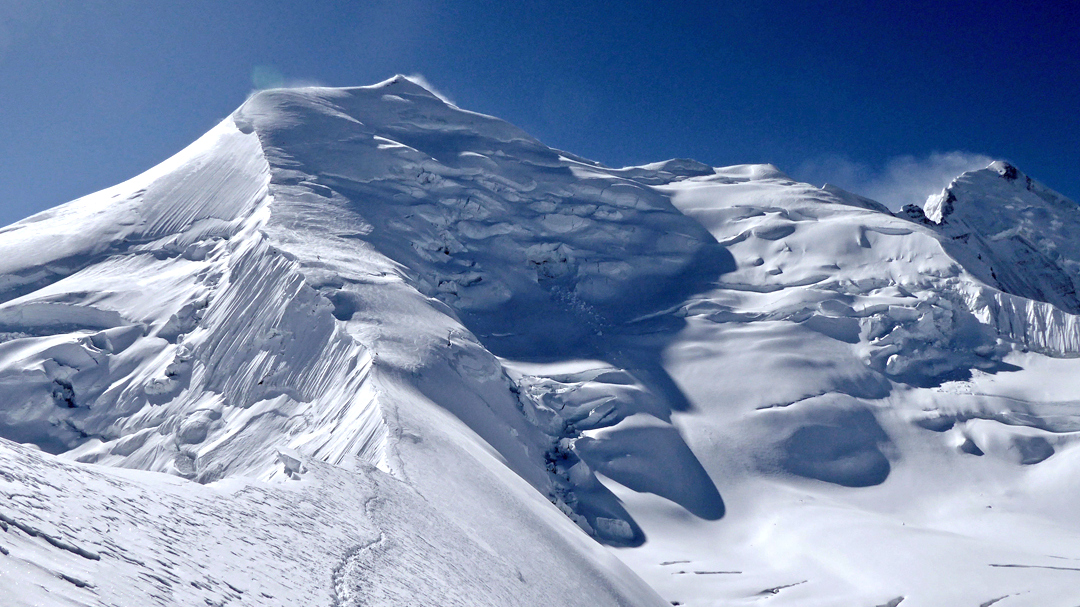
Spring (April to May)
- Temperature: During spring, temperatures at lower elevations are relatively mild, ranging from 10°C to 20°C (50°F to 68°F). However, temperatures at higher altitudes, including the summit, can drop to well below freezing, often reaching as low as -10°C to -20°C (14°F to -4°F).
- Weather: Spring is considered one of the best seasons for climbing Himlung Himal. The weather is relatively stable, with clear skies and low precipitation. However, occasional snowfall is still possible, especially at higher altitudes.
- Wind: Wind speeds tend to be moderate, but there can be occasional gusts, particularly at higher altitudes and on exposed ridges.
- Visibility: Clear skies provide excellent visibility, allowing climbers to enjoy panoramic views of the surrounding peaks and landscapes.
Autumn (September to October)
- Temperature: Similar to spring, temperatures at lower elevations are comfortable, ranging from 10°C to 20°C (50°F to 68°F). At higher altitudes, temperatures drop significantly, and frost and freezing conditions are common.
- Weather: Autumn is another favorable season for climbing Himlung Himal. The weather is generally stable, with clear skies and minimal precipitation. Rain and snowfall are less likely during this period.
- Wind: Wind speeds remain moderate, and conditions are generally less windy compared to other seasons.
- Visibility: Clear skies and good visibility offer spectacular views of the surrounding mountains and landscapes.
Winter (November to February)
- Temperature: Winter is characterized by extremely cold temperatures. At lower elevations, temperatures range from 0°C to 10°C (32°F to 50°F), but at higher altitudes, temperatures can plummet well below -20°C (-4°F) or even lower.
- Weather: Winter is considered a challenging time for climbing Himlung Himal due to the harsh weather conditions. Heavy snowfall, high winds, and storms are common. Climbers need to be well-prepared for extreme cold and challenging climbing conditions.
- Wind: Winter experiences strong and cold winds, which can increase the chill factor and create challenging climbing conditions.
- Visibility: Poor visibility due to snowstorms and cloud cover can limit the panoramic views that are typically enjoyed during other seasons.
Monsoon (June to August)
- Temperature: Temperatures are milder during the monsoon season, ranging from 15°C to 25°C (59°F to 77°F) at lower elevations. However, humidity levels are high.
- Weather: Monsoon is the least suitable season for climbing Himlung Himal. Heavy rainfall, landslides, and cloud cover are common, making the terrain slippery and navigation difficult.
- Wind: Wind speeds are generally lower during the monsoon season, but high-altitude winds can still pose challenges.
- Visibility: Cloud cover and rain can significantly limit visibility, hindering the panoramic views that climbers seek.
Accommodation and Food during the Himlung Himal Climbing
Accommodation and food during a Himlung Himal climbing expedition are essential considerations for ensuring climbers' comfort, well-being, and overall success. Here's what you can expect in terms of accommodation and food:
Accommodation
Accommodation during a Himlung Himal climbing expedition involves a combination of camping and staying in basic lodges or tea houses in the surrounding villages. Here's a breakdown of the accommodation arrangements at different stages of the expedition:
- Kathmandu: Before and after the expedition, climbers typically stay in hotels or guesthouses in Kathmandu. These accommodations offer a range of amenities and comfort levels.
- Trekking Route: As climbers trek toward Himlung Himal, they will pass through various villages along the Annapurna Circuit trail. These villages have tea houses or lodges where trekkers can stay. These accommodations are basic and may include shared rooms, simple bedding, and communal bathrooms. While these lodges offer modest comfort, they provide shelter and a warm place to rest.
- Base Camp: At the Himlung Himal base camp, climbers set up their own campsite. Base camp facilities are rudimentary and may include tents, dining tents, and basic kitchen facilities. Climbers and support staff share tents and sleeping arrangements. The focus at the base camp is on acclimatization, rest, and preparation for the summit push.
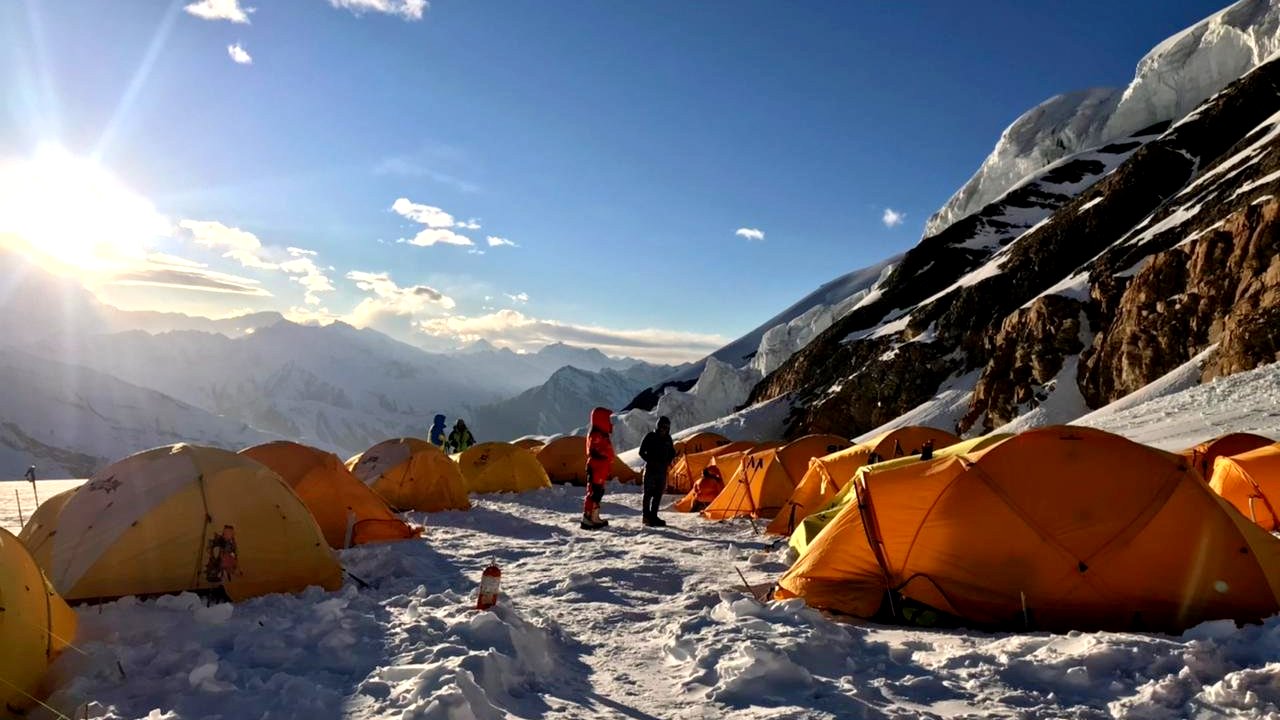
- High Camps: As climbers progress to higher altitudes, they establish high camps to aid in acclimatization and provide staging areas for the summit attempt. High camps involve even more basic camping arrangements, with climbers and Sherpa guides sharing tents and basic supplies.
Food
Food during a Himlung Himal climbing expedition is essential for maintaining energy levels and staying healthy. Here's what climbers can expect in terms of food:
- Trekking Route: Along the trekking route, climbers can enjoy meals at the tea houses or lodges. These establishments serve a variety of meals, including Nepali, Indian, and Western cuisine. Meals often consist of rice, dal (lentil soup), vegetables, noodles, bread, and tea. While the variety might be limited, the food is generally hearty and provides the necessary sustenance for trekking.
- Base Camp: At the base camp, meals are prepared by the expedition's support staff. A kitchen team cooks meals using portable stoves and basic cooking equipment. Meals typically include a combination of carbohydrates, proteins, and vegetables to fuel climbers' bodies during acclimatization and preparation.
- High Camps: As climbers ascend to high camps, meal options become more limited due to the challenging conditions. Meals are usually focused on providing energy and nutrients, with a focus on lightweight and easily prepared food items.
- Summit Push: During the summit push, climbers rely on high-energy snacks and easily digestible food items, as cooking facilities are limited or non-existent. Energy bars, nuts, chocolate, and other lightweight foods are often carried for quick energy boosts.
It's important to note that food options become more basic and limited as climbers ascend higher altitudes, and freshness may be compromised due to logistical challenges. Climbers often carry some of their own snacks and energy supplements to supplement their diet during the expedition.
Overall, climbers should be prepared for basic accommodations and simple meals while climbing Himlung Himal. Proper nutrition and hydration are critical for maintaining strength and stamina throughout the expedition, so climbers should plan and pack accordingly.
Permits for the Himlung Himal Climbing
Climbing Himlung Himal requires obtaining several permits and permissions from the Nepal government and relevant authorities. These permits are essential to ensure that climbers are undertaking the expedition legally and with proper oversight. Here are the main permits required for a Himlung Himal climbing expedition:
Climbing Permit: The primary permit required for climbing Himlung Himal is the climbing permit. This permit is issued by the Nepal government through the Department of Tourism (DoT) and is obtained through a registered trekking agency. The climbing permit specifies the dates of the expedition and the route to be followed. The cost of the climbing permit varies depending on the season and the number of climbers in the group.
Trekking Permits: Since the approach to Himlung Himal involves trekking through restricted areas, trekkers also need to obtain the necessary trekking permits. These permits are often obtained as a part of the overall expedition package through a trekking agency. The specific permits required can include:
- Annapurna Conservation Area Permit (ACAP): Required for trekking through the Annapurna Conservation Area.
- Manaslu Conservation Area Permit (MCAP): Required for trekking through the Manaslu Conservation Area.
TIMS Card: The Trekker's Information Management System (TIMS) card is required for all trekkers in Nepal. However, for climbing expeditions, the requirement for a TIMS card varies depending on the region and the trekking agency. Check with your trekking agency whether a TIMS card is necessary for your Himlung Himal expedition.
Local Area Permits: Some areas along the trekking route, especially when using alternative trails or entering certain villages, may require additional local area permits. These permits are usually obtained through the local authorities or the trekking agency.
It's important to note that permit requirements and regulations can change, so it's advisable to consult with a reputable trekking agency or a local authority to ensure that you have the most up-to-date information and that you obtain all the necessary permits before starting your Himlung Himal climbing expedition. Trekking agencies often assist climbers in obtaining these permits and managing the logistical aspects of the expedition, making the process smoother and more convenient.
Travel Insurance for the Himlung Himal Climbing
Travel insurance is an essential component of any mountaineering expedition, including a climb of Himlung Himal. Given the risks and challenges associated with high-altitude climbing, having comprehensive travel insurance is crucial to ensure your safety, cover potential medical expenses, and provide financial protection in case of unforeseen events. Here are some important considerations regarding travel insurance for a Himlung Himal climbing expedition:
- Coverage for High-Altitude Climbing: When selecting travel insurance, make sure it explicitly covers high-altitude mountaineering activities. Many standard travel insurance policies do not include coverage for activities involving altitudes above a certain level, typically 4,000 meters (13,123 feet). Since Himlung Himal exceeds this altitude, ensure that your policy covers climbing at such heights.
- Medical Evacuation and Rescue: High-altitude environments carry the risk of altitude sickness and other medical emergencies. Look for insurance that provides coverage for medical evacuation and rescue services, especially considering the remote locations and challenging terrain associated with Himlung Himal climbing.
- Emergency Medical Expenses: In the event of illness or injury during the expedition, your insurance should cover medical expenses, including hospitalization, treatment, and medication. Given the remote locations, you may need to be airlifted to a medical facility, which can be costly without insurance coverage.
- Trip Cancellation and Interruption: Unexpected circumstances such as flight cancellations, delays, or personal emergencies can disrupt your expedition. Look for insurance that offers trip cancellation and interruption coverage to reimburse you for non-refundable expenses like permits, guides, and accommodations.
- Gear and Equipment Coverage: Climbing Himlung Himal requires specialized gear and equipment. Ensure that your insurance policy covers the loss, theft, or damage of expensive mountaineering equipment.
- Pre-Existing Conditions: Some insurance policies may exclude coverage for pre-existing medical conditions. If you have any pre-existing conditions, check whether they are covered or if you can purchase additional coverage.
- Policy Duration and Extensions: Make sure your insurance policy covers the entire duration of your expedition, including acclimatization periods and potential delays due to weather conditions. Extensions might be necessary if you encounter unexpected delays.
- Coverage Limits and Exclusions: Carefully read and understand the policy's coverage limits, exclusions, deductibles, and terms. Some policies might have specific limitations for mountaineering activities or certain regions.
- Emergency Contact Information: Keep a copy of your insurance policy and emergency contact information readily accessible during the expedition.
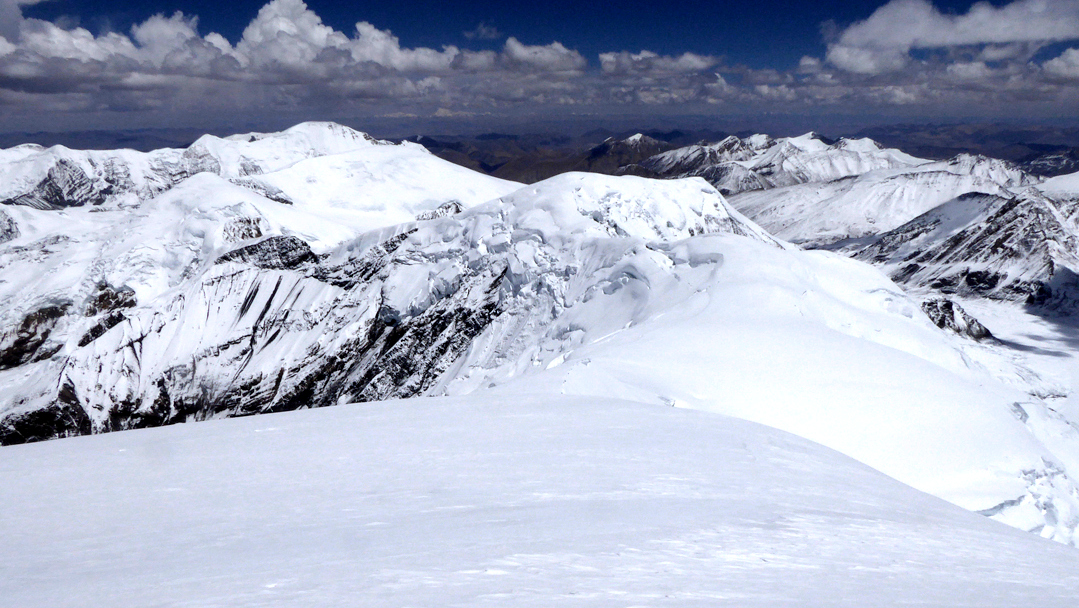
Checklist for Himlung Himal Climbing
Preparing for a Himlung Himal climbing expedition requires careful planning and organization. Here's a comprehensive checklist to help you ensure that you have all the necessary gear, equipment, documents, and essentials for a successful and safe climb:
Preparation and Logistics:
- Obtain climbing permits and necessary trekking permits (ACAP, MCAP, etc.).
- Arrange travel insurance that covers high-altitude climbing and emergencies.
- Confirm your travel itinerary, flights, and transportation to and from the starting point.
- Ensure you have all required documents (passport, permits, insurance policy, ID photos).
- Make advance accommodation reservations in Kathmandu and at the trekking route's tea houses.
Climbing Gear:
- Mountaineering boots (insulated and suitable for crampons).
- Crampons and crampon-compatible boots.
- Ice axe and harness.
- Climbing helmet.
- Ropes (dynamic and static) and carabiners.
- Ascenders, descenders, and prusik cords.
- Climbing harness and belay device.
- Snow and ice protection (cams, nuts, screws).
- Climbing slings and quickdraws.
- Avalanche safety equipment (probe, shovel, transceiver).
Clothing:
- Base layers (moisture-wicking and insulating).
- Insulated mid-layers (fleece or down jackets).
- Waterproof and windproof shell jacket and pants.
- Insulated pants or bibs.
- Gaiters (for keeping snow out of boots).
- Warm gloves and mittens (inner and outer layers).
- Hat for sun protection and warmth.
- Balaclava or neck gaiter.
- Sunglasses with UV protection (glacier glasses recommended).
- High-quality sunscreen and lip balm with high SPF.
- Hand and foot warmers.
Equipment:
- Sleeping bag suitable for high altitudes (rated for low temperatures).
- Sleeping pad or mattress.
- Lightweight backpack for summit attempts.
- Duffel bag for base camp equipment.
- Daypack for trekking and acclimatization hikes.
- Headlamp with spare batteries.
- Water bottles and water purification methods.
- Personal first aid kit with essentials and medications.
- Personal toiletries (toilet paper, hand sanitizer, wet wipes).
- Trekking poles for added stability.
- Camera and spare batteries (optional).
Climbing and Safety Accessories:
- Helmet-mounted headlamp.
- Pocket knife or multi-tool.
- Map, compass, and GPS device (if necessary).
- Climbing journal or notebook.
- Satellite communication device (if available and necessary).
- Emergency shelter or bivouac sack.
Miscellaneous:
- Cash (Nepali rupees) for tips, purchases, and emergencies.
- Energy bars, snacks, and high-energy food items.
- Entertainment (books, music, cards) for downtime.
- Power bank for charging electronic devices.
- Portable altitude sickness medication (Diamox).
- Spare batteries for electronic devices.
- Repair kits for gear and clothing.
Documents and Communication:
- Passport and photocopies.
- Climbing permits and trekking permits.
- Travel insurance policy and contact information.
- Emergency contact numbers (family, embassy, local authorities).
- Communication devices (satellite phone, two-way radios).
Training and Preparation:
- Engage in physical fitness training, cardiovascular conditioning, and strength training.
- Acquire mountaineering skills through training or courses.
- Practice using climbing equipment and ropes.
- Simulate high-altitude conditions during training hikes.
Before embarking on your Himlung Himal climbing expedition, ensure that you are physically and mentally prepared for the challenges ahead. Consult with experienced climbers, hire experienced guides, and thoroughly research the route and conditions to maximize your chances of a successful and safe climb. Remember that this checklist is comprehensive; adjust it based on your personal needs, preferences, and the specific requirements of the expedition.
Tips for the Putha Hiunchuli (7,246 m) Climbing
Climbing Putha Hiunchuli (7,246 meters) is a challenging endeavor that requires thorough preparation, technical skills, and careful planning. Here are some tips to help you have a successful and safe climbing experience on Putha Hiunchuli:
- Choose a Reliable Operator: Select an experienced expedition company such as Luxury Holiday Nepal for guidance and support.
- Prioritize Fitness: Engage in well-rounded fitness training for endurance and stamina.
- Acquire Technical Skills: Develop ice, rock, and rope skills before the climb.
- Plan Acclimatization: Schedule gradual ascents and multiple rotations for acclimatization.
- Pack Appropriate Gear: Carry essential climbing gear, including boots, crampons, and ropes.
- Research the Route: Familiarize yourself with the route, terrain, and potential hazards.
- Obtain Permits: Secure climbing and trekking permits ahead of time.
- Prepare for Weather: Pack for changing weather, including cold and snow.
- Pack Light but Essential: Minimize gear load while ensuring you have the necessary items.
- Stay Hydrated and Nourished: Maintain hydration and proper nutrition at high altitudes.
- Follow Safety Protocols: Adhere to safety guidelines and communicate with your team.
- Practice Hygiene: Maintain cleanliness and sanitation to prevent illnesses.
- Respect Local Culture: Show respect for local customs and traditions.
- Stay Positive and Adaptable: Maintain a positive attitude and be adaptable to changes.
- Consider the Environment: Follow Leave No Trace principles and minimize impact.
Following these tips will help you prepare adequately and navigate the challenges of climbing Putha Hiunchuli successfully and safely.
Frequently asked questions (FAQs) for climbing Himlung Himal
Q: What is the elevation of Himlung Himal?
A: Himlung Himal stands at an elevation of 7,126 meters (23,345 feet) above sea level.
Q: What is the best season to climb Himlung Himal?
A: The best seasons to climb Himlung Himal are spring (April to May) and autumn (September to October) when weather conditions are stable, and visibility is clear.
Q: Is previous mountaineering experience required to climb Himlung Himal?
A: While prior mountaineering experience is highly recommended, some guided expeditions cater to climbers with limited experience. However, participants should have strong physical fitness and mental determination.
Q: Do I need a climbing permit to ascend Himlung Himal?
A: Yes, a climbing permit is required. It can be obtained through a registered trekking agency and the Department of Tourism in Nepal.
Q: What type of technical gear is needed for Himlung Himal?
A: Essential gear includes mountaineering boots, crampons, ice axe, harnesses, helmets, ropes, and climbing protection. The specifics depend on the chosen route and conditions.
Q: Is travel insurance necessary for climbing Himlung Himal?
A: Yes, comprehensive travel insurance that covers high-altitude mountaineering, emergency medical evacuation, and trip interruption is essential.
Q: How long does a typical Himlung Himal climbing expedition take?
A: The duration of an expedition can vary, but it usually takes around 3-4 weeks, including trekking, acclimatization, and summit attempts.
Q: What kind of accommodation is available during the climb?
A: Accommodation ranges from hotels or guesthouses in Kathmandu to basic lodges or tea houses along the trekking route. During the climb, climbers set up camps at base camp and high camps.
Q: How physically fit do I need to be to climb Himlung Himal?
A: Climbers should have excellent cardiovascular fitness, strength, endurance, and mental resilience to handle the demands of high-altitude climbing.
Q: What are the risks associated with climbing Himlung Himal?
A: Risks include altitude sickness, extreme weather, avalanches, crevasses, and technical challenges. Proper training, preparation, and adherence to safety protocols mitigate these risks.
Q: Is there communication available during the climb?
A: Communication can be limited in remote areas, but some expeditions provide satellite phones or other devices for emergency communication.
Q: How much should I budget for a Himlung Himal climbing expedition?
A: The budget varies based on factors like the expedition package, guide fees, permits, equipment, and travel expenses. It's advisable to plan for a comprehensive budget that covers all aspects of the climb.
Q: Is it possible to combine Himlung Himal with other nearby treks or climbs?
A: Yes, the Annapurna Circuit and other nearby treks can be combined with Himlung Himal expeditions to create longer and more diverse adventure experiences.
6000-meter peaks for Climbing and Expedition Packages in Nepal
Mt Ama Dablam Expedition (6,812 m)
Island Peak Expedition (6,160 m)
Mera Peak Climbing (6,476 m)
Chulu West Peak Climbing (6,419 m)
Pisang Peak Climbing (6,091 m)
Singu Chuli Peak Climbing (6,501 m)
8000-meter Mountain Expedition in Nepal
Makalu Expedition (8,463m)
Manaslu Expedition (8,163 m)
Kanchenjunga Expedition (8,586 m)
Lhotse Expedition (8,516 m)
Mt. Everest Expedition (8848.86 m)
Dhaulagiri Expedition (8,167 m)
7000-meter peaks for Climbing and Expedition in Nepal
Gangapurna Expedition (7,455 m)
Pumori Expedition (7,145 m)
Tilicho Peak Expedition (7,134 m)
Annapurna South Expedition (7,219 m)
If you need any further information, please contact us, Email: at [email protected], Phone: at +977- 985 100 5129 (WhatsApp)




